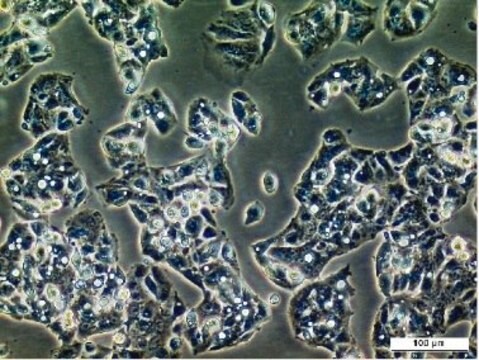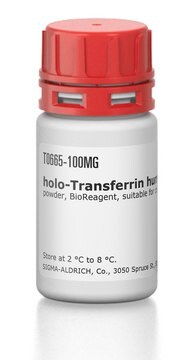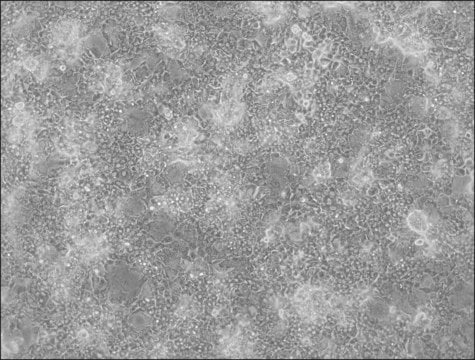SCC249
Hep-G2/2.2.15 Human Hepatoblastoma Cell Line
The Hep-G2/2.2.15 human hepatoblastoma cell line is a suitable model for research into many aspects of HBV-associated liver cancer.
Synonyme(s) :
Hep-G2/2215
Se connecterpour consulter vos tarifs contractuels et ceux de votre entreprise/organisme
About This Item
Code UNSPSC :
41106514
Produits recommandés
Application(s)
cell analysis
Description générale
Hepatocellular carcinoma is the primary malignancy of the liver and a leading cause of cancer-related death in the world. The etiology of hepatocellular carcinoma is closely linked to infection with hepatitis B virus (1). Because of the causative role of HBV in liver cancers, cellular models of HBV-infected hepatocellular carcinomas have been developed for understanding the progression and fundamental biology of liver cancers.
The Hep-G2/2.2.15 human hepatoblastoma cell line, a subclone of HepG2 human hepatoblastoma that stably expresses the hepatitis B virus, is one of the most widely used models for HBV-associated liver disease. Hep-G2/2.2.15 cells possess lower proliferation and invasion activity than parental HepG2 cells and have low tumorigenicity in nude mice (2). Like parental HepG2 cells, Hep-G2/2.2.15 cells express the microtubule-associated marker doublecortin (DCX).
<bold>Source:</bold>
Hep-G2/2.2.15 was produced from Hep-G2 cells stably transformed with the hepatitis-B virus (HBV) genome. Hep-G2/2.2.15 cells are resistant to G418 and contain two head-to-tail dimers of the HBV type D genome (3). The parental HepG2 cell line was isolated from hepatoblastoma tissue of a 15-year-old male patient (4).
Research Category:
The Hep-G2/2.2.15 human hepatoblastoma cell line, a subclone of HepG2 human hepatoblastoma that stably expresses the hepatitis B virus, is one of the most widely used models for HBV-associated liver disease. Hep-G2/2.2.15 cells possess lower proliferation and invasion activity than parental HepG2 cells and have low tumorigenicity in nude mice (2). Like parental HepG2 cells, Hep-G2/2.2.15 cells express the microtubule-associated marker doublecortin (DCX).
<bold>Source:</bold>
Hep-G2/2.2.15 was produced from Hep-G2 cells stably transformed with the hepatitis-B virus (HBV) genome. Hep-G2/2.2.15 cells are resistant to G418 and contain two head-to-tail dimers of the HBV type D genome (3). The parental HepG2 cell line was isolated from hepatoblastoma tissue of a 15-year-old male patient (4).
Research Category:
- Cancer
- Infectious Diseases
Origine de la lignée cellulaire
Human, Hepatocyte Cells;Cancer Cells
Conditionnement
≥1X106 cells/vial
Stockage et stabilité
Store in liquid nitrogen. The cells can be cultured for at least 10 passages after initial thawing without significantly affecting the cell marker expression and functionality.
Autres remarques
This product is intended for sale and sold solely to academic institutions for internal academic research use per the terms of the “Academic Use Agreement” as detailed in the product documentation. For information regarding any other use, please contact licensing@emdmillipore.com.
Clause de non-responsabilité
RESEARCH USE ONLY. This product is regulated in France when intended to be used for scientific purposes, including for import and export activities (Article L 1211-1 paragraph 2 of the Public Health Code). The purchaser (i.e. enduser) is required to obtain an import authorization from the France Ministry of Research referred in the Article L1245-5-1 II. of Public Health Code. By ordering this product, you are confirming that you have obtained the proper import authorization.
This product contains genetically modified organisms (GMO).
Within the EU GMOs are regulated by Directives 2001/18/EC and 2009/41/EC of the European Parliament and of the Council and their national implementation in the member States respectively. Unless otherwise stated in our catalog or other company documentation accompanying the product(s), our products are intended for research use only and are not to be used for any other purpose, which includes but is not limited to, unauthorized commercial uses, in vitro diagnostic uses, ex vivo or in vivo therapeutic uses or any type of consumption or application to humans or animals.
Within the EU GMOs are regulated by Directives 2001/18/EC and 2009/41/EC of the European Parliament and of the Council and their national implementation in the member States respectively. Unless otherwise stated in our catalog or other company documentation accompanying the product(s), our products are intended for research use only and are not to be used for any other purpose, which includes but is not limited to, unauthorized commercial uses, in vitro diagnostic uses, ex vivo or in vivo therapeutic uses or any type of consumption or application to humans or animals.
Code de la classe de stockage
12 - Non Combustible Liquids
Classe de danger pour l'eau (WGK)
WGK 1
Point d'éclair (°F)
Not applicable
Point d'éclair (°C)
Not applicable
Certificats d'analyse (COA)
Recherchez un Certificats d'analyse (COA) en saisissant le numéro de lot du produit. Les numéros de lot figurent sur l'étiquette du produit après les mots "Lot" ou "Batch".
Déjà en possession de ce produit ?
Retrouvez la documentation relative aux produits que vous avez récemment achetés dans la Bibliothèque de documents.
Notre équipe de scientifiques dispose d'une expérience dans tous les secteurs de la recherche, notamment en sciences de la vie, science des matériaux, synthèse chimique, chromatographie, analyse et dans de nombreux autres domaines..
Contacter notre Service technique






